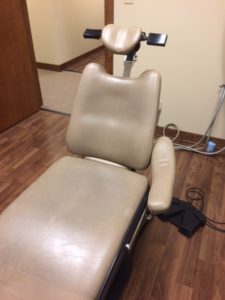 After following a chain of referrals from my dentist; first, his endodontist, then, his oral surgeon, I knew I needed to heed their advice about my lower left back molar.
After following a chain of referrals from my dentist; first, his endodontist, then, his oral surgeon, I knew I needed to heed their advice about my lower left back molar.
It has to go.
Apparently, there was an infection deep in the root, and a little grinding during my sleep on top of normal wear, I assume, made things worse.
I had the oral surgeon’s office work up prices two ways; for just the extraction and for the extraction if I was put under.
I had a general anesthetic five years ago when I had my wisdom teeth removed. I had all four extractions performed at the same time, so this seemed to be the way to go. But for one tooth — I just chose to have a local.
I didn’t want to be absent. I just wanted to be comfortably numb.
Ah, the mouth is a mysterious organ. Should it even be thought of as an organ? Is it part of the digestive system or part of the respiratory system?
Maybe the most intimate of all human acts, kissing, is a mouth thing.
And symbolically, energetically, having a tooth removed can be steeped in meaning. It seems important to cut out unhealthy teeth or infectious tissue from under the surface of things, or to remove a tooth in order for neighboring teeth to settle into a good alignment.
As directed, I made arrangements for someone to drive me to the practice on the appointed day. Although I had pretty much made up my mind to go with local vs. general anesthesia, I didn’t eat in the morning in case I changed my mind. I wore comfortable, loose fitting clothes.
I stocked up on homeopathic remedies to reduce swelling and decrease chances for infection. I cleared social activities from my calendar.
It seemed like a major undertaking, and yet, after I filled out all my consent forms and was led to a room in the back of the complex, my first thought was how unremarkable the chair looked.
Like allowing drying time between applying coats of paint, providing pain blockers for a dental procedure is done in layers.
After I situated myself in the chair and his assistant adjusted the neck rest, the surgeon entered the room and explained the sequence. He traced the area around the affected tooth with a pink gel coated extra-long cotton-tipped swab, then left the room.
He poked his head back in the room after five minutes, just long enough to ask,
Are you starting to feel numb on the left side of your mouth?
A few minutes later, he came back and shot my gum up with a syringe. The needle penetrated my gums at least five times.
Not able to enunciate very clearly, I made a face. As if he read my mind, he said something akin to agreeing with me that the contents of the syringe tasted awful. Then he left the room again.
A couple minutes later, he came back and asked me about my ability to feel the edges of small instruments he placed at different points of my gum near the tooth that had to go. He followed up with a strange gesture, pinching the sides of my left cheek and pulling it away from my jaw, then shaking this little handful of my flesh.
I wasn’t given fancy dark glasses. I was just told to close my eyes. He put a small black piece of plastic in my mouth to make sure I kept my jaw open wide enough for him to work.
I felt some pressure, but no pain.
One stitch was made to close the hole in my gum after the molar was removed. A wad of gauze was placed where my infected tooth used to be. I was told to bite down on it for the next hour and not to brush my teeth, only to rinse with salt water, for a day.
In twenty minutes, it was done. The hardest part for me was not gagging when they put the spacer in my mouth.
I concluded that my uneventful procedure was pretty remarkable. Though I don’t give such things much thought, local anesthesia, rendering very defined parts of my body numb while excavating something that could cause me health problems, is quietly incredible.
Sitting, comfortably numb, in an oral surgeon’s chair is no small thing.


Leave a comment